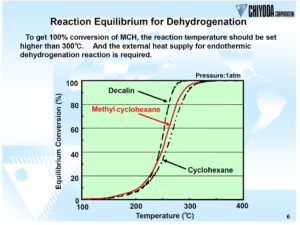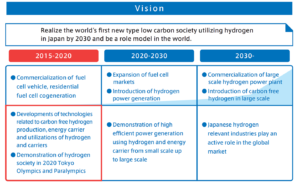Japan-Brunei MCH Energy Carrier Demonstration
By Stephen H. Crolius on August 02, 2017
Chiyoda Corporation, the multinational chemical engineering firm that is arguably the leading proponent of the methyl cyclohexane (MCH) method of hydrogen transport, will start work this month on a project to demonstrate MCH technology in a real-world context. As reported in a July 27 company press release, the project will involve the transportation of hydrogen from Brunei to Japan in what the company states is “the world’s first global hydrogen supply chain demonstration project” — an assertion that many ammonia energy proponents will no doubt find preposterous.
MCH (C7H14) is the hydrogenated member of a chemical pair that can be used to store and transport hydrogen. Toluene (C7H8) is the dehydrogenated member. This pair is one of a number that have been proposed and studied under the rubric of “liquid organic hydrogen carriers” (LOHCs).
Chiyoda’s Announcement
Chiyoda will be joined in the demonstration by the trading arms of Japanese conglomerates Mitsubishi and Mitsui, as well as the ocean freight company NYK Line, another arm of Mitsubishi. Hydrogen will be extracted from natural gas at an LNG plant in Brunei (that, per a story in Argus Media, is one-quarter owned by Mitsubishi) and combined with toluene in a reactor that will be built for the demonstration. The MCH product will be transported to the city of Kawasaki in Japan. While the distance is substantial — 4,500 km (2,800 miles) – it is just a fraction of the trip to Japan from Australia or the petroleum-rich countries of the Middle East. Once in Kawasaki, the MCH will be dehydrogenated in another specially built reactor. The resulting hydrogen stream will be mixed with natural gas before being burned in an electrical generation plant.
The project’s construction phase will start this month and run through December 2019. The operational phase will start in January 2020 and run through December of that year. Up to 210 tonnes of hydrogen will be transported in that period. The project is being funded by the Government of Japan’s New Energy and Industrial Technology Development Organization (NEDO).
Competitive Dynamics with Ammonia
This is a major development in Japan’s Cross-Ministerial Strategic Innovation Program (SIP) Energy Carriers initiative. As reported previously in Ammonia Energy, so far the only visible activity related to energy carriers outside the R&D laboratory has been investment in “last-mile” fueling infrastructure, especially hydrogen fueling stations.
The word “competition” does not appear in the SIP literature, but one needs only scratch the surface of the Energy Carriers Road Map to see that the technologies will be pitted against each other. The Road Map says that the first phase of work in 2015-2020 will be devoted to the “development of technologies related to carbon free hydrogen production, energy carriers, and utilization of hydrogen and carriers.” Although it is unstated, a reasonable person would expect that the energy carrier that has the most momentum at the time of the Tokyo Olympics in 2020 will receive government backing for the subsequent phase of demonstrating “high efficient power generation using hydrogen and energy carrier from small scale up to large scale.” Indeed, Chiyoda’s press release states that “the project will be constructed considering the Phase II of the ‘Strategic Road Map for Hydrogen and Fuel Cells,'” and that it “aims to realize Global Hydrogen Transport and Supply Technology for full-scale Hydrogen Power Generation around 2030.”
A reasonable person might also wonder how MCH will fare when and if it comes to a head-to-head match-up against ammonia on a level playing field. The contest is likely to be decided by factors in two parts of the “value chain” of hydrogen energy: 1) the cost of putting hydrogen into a tractable form; and 2) the cost of transport from the point of production to the point of use.

In both cases, the process of chemical manipulation – of reducing nitrogen to produce NH3 and hydrogenating toluene’s aromatic ring to produce MCH – involves heat, pressure, and, for MCH, precious-metal catalysts. This is not to say that the cost footprints of the two processes are necessarily equal. At the same time, though, there is no obvious basis to argue that the MCH process is categorically different and less expensive than the NH3 process. This is especially true because the MCH process involves a second chemical manipulation – this one at the other end of the logistics chain, in which the MCH is dehydrogenated back to toluene. This process is likely to be less costly than the preceding one since it proceeds in the downhill direction of the energy gradient. Nonetheless, a plant is required and the capital and operating expense involved have no analogue on the NH3 side of the competition. (It should be noted that the research for this story included an unsuccessful effort to identify published accounts of the economics of the toluene-to-MCH conversion process, or even the thermodynamics of Chiyoda’s toluene hydrogenation process.)
Firmer conclusions can be drawn in the transport part of the value chain. The energy density of NH3 is 2.5 times greater than the effective energy density of the hydrogen carried by MCH (18.6 MJ of energy per kg for ammonia vs. 7.4 for MCH). This is because each molecule of MCH contains only six hydrogen atoms that can be detached and turned into diatomic H2 molecules. So that while the MCH molecule weighs 98 grams per mole, only six of these grams are composed of usable hydrogen. The result at scale is an ocean tanker that is laden with 50,000 tonnes of liquid cargo yet delivers only 3,100 tonnes of H2 – which stands in contrast to the 8,900 tonnes of H2-equivalent that is aboard a ship laden with 50,000 tonnes of ammonia.
The disadvantages for MCH do not stop there, however. The Argus Media story contains the acknowledgement that “toluene removed from MCH will be transported back to Brunei for use in the hydrogenation process at the demonstration plant.” This clearly would set up an additional set of cost-generating activities: collecting the 46,900 tonnes of dehydrogenated toluene and reloading it onto the ocean tanker; transporting it back to Brunei; offloading it and storing it while it awaits rehydrogenation; and replenishing the small proportion of the material that is inevitably degraded or lost during each iteration of the cycle.
It should be acknowledged that ocean tankers often return to ports of original embarkation laden only with ballast because countries that export petroleum, for example, generally do not import other bulk liquids in the same volume. This means that the cost of the backhaul often cannot be counted as a disadvantage for MCH vs. ammonia. (Interestingly, in the specific case of arid-climate energy-exporting regions, it has been credibly proposed that tankers could be used to import fresh water with cost and greenhouse gas savings vs. desalination of sea water.)
When LOHCs Lost to Ammonia
Without quantitative estimates for relevant parameters, the comparisons of the cost factors above can only be indicative and could even be misleading. However, it is worth noting that another government agency in another country evaluated the case for LOHCs vs. ammonia and apparently determined that ammonia is the clear winner.
In August 2015, the United States Department of Energy Advanced Research Projects Agency – Energy (ARPA-E) held a workshop with the title “Bridging Renewable Electricity with Transportation Fuels.” The goal of the workshop was to identify “zero-emission regenerable fuels” that could “replace fossil fuels,” thereby “reducing greenhouse gas emissions and preserving energy security.” According to the prospectus, the workshop would convene “leading experts in electrochemistry, catalysis (hydrogenation and dehydrogenation), fuel cells and electrolyzers, organic synthesis and fuels.” The prospectus also contained numerous mentions of technologies like “hydrogenation of reversible organic carriers.” At the workshop itself, the German company Hydrogenious, a leading proponent of LOHCs, was given one of only four presentation slots devoted to advocacy of a particular technology. (NH3 Fuel Association Board member Steve Wittrig was given another one on behalf of ammonia.)
Eight months later, ARPA-E announced a “new funding opportunity” for a program it dubbed Renewable Energy to Fuels through Utilization of Energy-dense Liquids (REFUEL). The stated mission of the program was to “develop technologies that convert water and air into CNLFs [carbon-neutral liquid fuels] using chemical or electrochemical processes powered by renewable electricity sources, such as wind and solar.” This framing did not close the door to LOHCs, but the reference to air as a process input seemed to be pointing away from the use of a “reversible organic carrier.”
Eight months after that, ARPA-E announced that 16 proponent teams would receive awards from the initial round of REFUEL funding. As reported in Ammonia Energy (in separate stories on synthesis- and use-side projects), 13 of the successful teams proposed ammonia-related projects. Two teams are focused on dimethyl ether and one is focused on ethanol. It is not known if any LOHC projects were proposed, but it is certainly the case that none were funded.
In the meantime, ammonia energy proponents in Japan are continuing their work in areas such as ammonia cracking technologies and ammonia-powered gas turbines, undistracted by the need to demonstrate the ammonia logistics chain. Needless to say, this logistics chain is being demonstrated globally every day, with the handling and use of hundreds of thousands of tonnes of ammonia.
